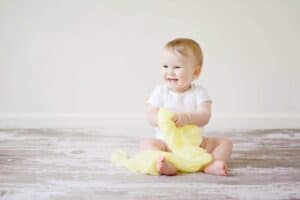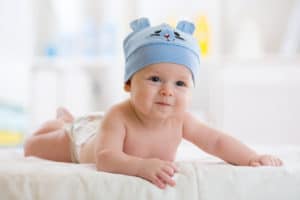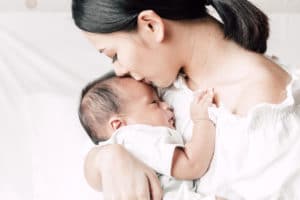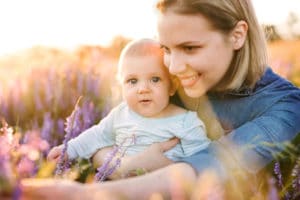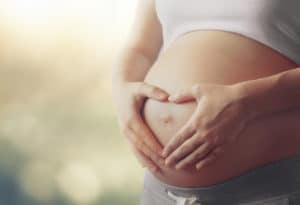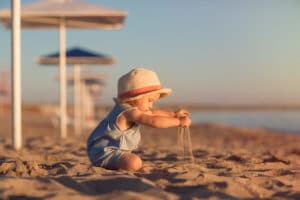Sun protection for the baby is an issue for most parents, especially in the summer. But even the first rays of the sun in spring can have an effect on a baby’s delicate skin. The skin of babies and toddlers is particularly sensitive.
It is very thin and does not yet have its own UV protection, which only builds up over the first few years of life. It is not until they are about 15 years old that children have a certain degree of skin protection.
To avoid the harmful effects of the sun and prevent long-term sun damage, sun protection for babies is essential. This is not only true if you want to go on vacation with your baby or child at the seaside. Your offspring can also get sunburned in the garden at home.
Table of contents
Sun Protection For The Baby: Why Is The Sun So Dangerous For Babies?
Many babies have very light, thin skin. It reacts much more quickly to external influences than the skin of adults. It is not for nothing that parents like to buy clothing made of organic cotton and avoid fragrances in creams and fabric softeners.
But when it comes to sun protection for babies, it is only in recent years that awareness has developed of how dangerous the sun can be for the smallest ones.
Due to the skin’s high sensitivity to light, babies get sunburn much more quickly, with permanent damage. Around 80 percent of the often permanent sun damage occurs before adulthood.
Sun protection for babies is also important because sun damage is usually not just a temporary sunburn. Dermatologists have been pointing out for some time that the skin doesn’t forget.
Any exposure of the skin to excessive sunlight can lead to skin cell changes. If such sun damage accumulates over the years, for example if you take regular vacations with your baby, the risk of skin cancer increases later in life. Do you know what the right sun protection for your baby looks like?
How Much Sun Can Babies’ Skin Tolerate?
From the age of 0 to 12 months, direct sun is taboo for babies. You should therefore make sure to protect your child from direct sunlight. Of course, babies can and should spend time outdoors.
For children under one year of age, however, the following always applies: in the shade, with suitable sun protection for the baby, and never in the midday heat. How long a child’s skin may be exposed to the sun so that the body can form the all-important vitamin D depends on the individual skin type.
However, because sun protection is so important for the baby, vitamin D is often supplemented in the first months of life if it cannot be formed through indirect sun exposure. You don’t have to worry, therefore, that sunscreen for baby will be detrimental to the formation of vitamin D.
Sun Protection For The Baby With Sunscreen
Sunscreen should not only be a companion when going on vacation with the family. Also during a walk in the park, a picnic in the garden or on the playground, the appropriate sun protection belongs.
Which Sunscreen For The Baby Protects Properly?
For children under one year of age and beyond, you should always use the highest possible sun protection factor (SPF). It indicates the factor by which the skin’s own protection time is extended.
Since this factor is theoretically zero for babies, even a sunscreen with SPF 50 is not a free pass for the blazing sun. However, it can help to protect the baby’s sensitive skin from sun damage.
When it comes to sun protection for baby, sunscreens with an SPF of at least 30 are recommended. Most designated means for the sun protection of babies are anyway declared with SPF 50.
Furthermore, make sure that the sunscreen for the baby also has an appropriate age recommendation. Some products are released from 0 months, others are recommended only from 6 months.
There are sunscreens with mineral protection, sunscreens with chemical UV filters, and mixed variants. Against harmful sun rays, all products that work well against UV-A and UV-B rays with an SPF of at least 30 usually work well.
For children’s sensitive skin, however, you should make sure that alcohol and fragrances are not included as ingredients with a high percentage in the sunscreen for the baby. Creams with mineral filters are somewhat more difficult to spread on the skin and whiten slightly, but protect immediately.
Sunscreens with purely chemical filters spread better, but may take a short time to work.
If you are unsure about which sunscreen to choose for baby, you can also get information from your pediatrician or the regular publications of Ökotest.
How Should I Apply The Sunscreen For My Baby?
In addition to the SPF, the application to the skin is important so that the sunscreen can develop its full protection on the baby. Apply a generous amount of sunscreen to your baby’s skin and also spread it on and behind the ears, on the back of the neck, and especially on the so-called sun terraces on the face.
These describe those areas that are heavily exposed to the sun: Nose and cheeks. Basically, all exposed skin areas should be treated with sunscreen for the baby. The timing of the application is also relevant: It is best to cream your child 30 minutes before going outside.
Sunscreen for the baby must be regularly reapplied so that it does not lose its effect. This is especially true if you are at the seaside with baby and child and you go into the water.
Although most products are described as waterproof and smudge-proof, regular reapplication is still mandatory. By the way, this does not prolong the sun protection for the baby.
Sun Protection For The Baby With Clothing
Clothing is the easiest way to protect your baby from the sun. The UV protection offered by baby clothing depends on the material and weave. There are also special UV clothes for the baby. But also a headgear made of fabric should always be worn in the summer. A sun hat for the baby protects and looks cute at the same time.
UV Clothing For The Baby
UV clothing for children can now be found more and more often in stores. It is a must when you go to the sea with a baby or child. This special clothing is usually available as swimwear, such as shorts and T-shirts, but also long-sleeved tops, swim trunks, and swimsuits.
It usually comes with a UV protection factor (UPF) of 50. Especially in regions where the sun shines particularly strongly, it saves the need to apply the cream to the affected areas of the skin and is easy to take off and put on.
Sun Hat For The Baby
Babies and children should always wear a sun hat when they go outside in the summer. It not only protects against sunburn on the delicate scalp and face. The risk of sunstroke is also particularly high for babies.
Make sure your baby’s sun hat has a neck guard and a brim or peak to provide shade for the face. Sun hats for babies are often already offered with integrated UV protection. Practical are models with ribbons that you can tie under the chin – so the headgear is not lost.
Sun Protection For The Baby On The Way
On walks and in the car – wherever the sun reaches your baby unfiltered, it can also cause damage to the skin. When it comes to sun protection for the baby on the road, there are different variants that protect against skin damage.
Sun Protection While Walking
If your baby is in a stroller, you can use either an adjustable sunshade or a sun sail. If you use a baby car seat as an attachment, you can usually fold out a sunshade that has a UV protection of at least 50.
If the child is in the baby carrier, you should check whether it has a sunshade for the baby. Most carriers have a foldable piece of fabric that can be passed over the head. A sun hat for the baby can also be a good alternative here.
Many parents still use gauze cloths to cover the stroller or infant carrier. However, this is not recommended. Most of these clothes are so tightly woven that they allow little air to pass through. However, babies must always be able to breathe freely, especially in hot weather. Try it yourself by putting such a cloth over your head.
Sun Protection When Driving
If you are traveling with your baby in the car, you should also check how much sun the windows let through. There is less danger with tinted windows. However, if they are very translucent, there are different variants for car sun protection.
Sun Protection On The Beach
If you are on vacation with your baby or child at the seaside, a UV-protected retreat is also important. A beach shell made of appropriate material protects you from wind and sun at the same time.
But also a large parasol or a beach chair can be arranged in such a way that they provide sufficient shade. Again, if you are traveling with a baby or child by sea, you should avoid the midday heat between 11 a.m. and 3 p.m
To play in the sand and swim in the water, of course with sunscreen, the morning and afternoon are ideal. In between, lunch and a nap fit, then the vacation on the beach can continue.
Sun Protection For The Eyes
It is perhaps a strange thought that when sun protection for the baby also makes sense glasses. However, children’s eyes are much more sensitive than adults because their pupils are larger and the lenses of their eyes are bigger.
Accordingly, they offer the sun more surface to attack. Sunglasses for babies are definitely not a must, but they can be an option. Do you want to go to the sea with your baby or child? Then you should also consider that the sun is strongly reflected by the water and can blind your child.
Glasses as sun protection for the baby should always have the appropriate UV protection and a high anti-glare category. For the little ones, there are very flexible models with elastic bands that hold the glasses firmly on the child’s head.
Sun Protection Is Also A Matter For Parents
Now you know what good sun protection for the baby looks like. On the one hand for everyday life and leisure at home and on the other hand for vacation, when you are traveling with baby or child at the sea


